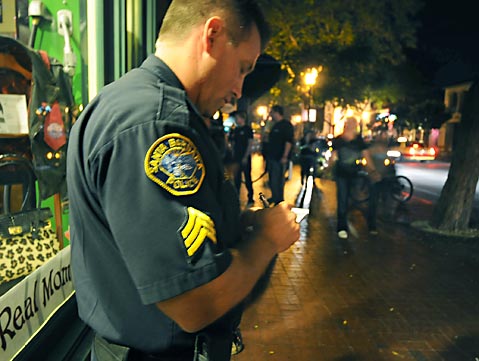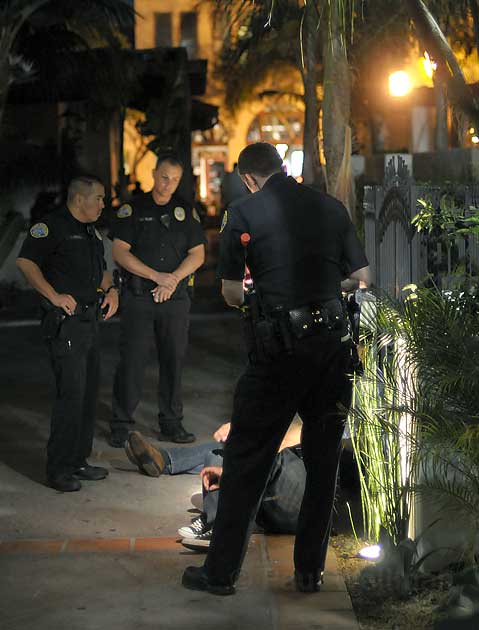Do Bars & Nightclubs Pay Their Fair Share?
Politicos Ponder New 'Entertainment' Exaction for Lower State Street Establishments

Santa Barbara city cops are more than a bit nervous. UCSB graduation is right around the corner, and graduating seniors have four to five years of compressed steam to blow off. That means Santa Barbara’s flourishing nightlife scene-epicentered along the 400, 500, and 600 blocks of State Street-should be considerably friskier than usual this coming weekend.
On a typical Friday or Saturday night, city cops estimate anywhere from 2,000-8,000 mostly young-and relatively inexperienced-drinkers hit the bars, nightclubs, and restaurants that make up the city’s thriving, boisterous entertainment district. Even with smaller numbers, bar time can pose serious crowd-control challenges. But this weekend, police are bracing for bigger crowds.
During a graduation party three years ago, a typical bar-closing fight at one downtown club where UCSB students-mostly African-American-were partying erupted into what police termed a mini-race riot. It took police an hour to get the 300 people who spilled out onto the sidewalk under control. Participants insisted it was the officers who lost control, taking complaints of excessive force first to City Hall and then to federal courts. Ultimately, allegations of civil rights abuse were rejected and misdemeanor charges filed against several of the students were upheld.

Around City Hall, the downtown entertainment district is the subject of constant comment and contention. Hotel owners complain that city police aren’t enforcing the existing noise and crowd rules and contend that the bars and nightclubs actually cost City Hall far more-in the form of heightened police services-than they ever bring in via sales and business taxes. Bar owners counter they’re doing everything possible to self-police their own premises, and point proudly to the thousands of paying customers they bring downtown who would not otherwise come.
Typically, every year at budget time, members of the City Council will hear from hotel owners and members of the city’s Fire and Police Commission on how they should exact a much bigger take from downtown’s highly lucrative libation sales. In years past, such exhortations have failed to gain traction, the idea being dismissed as impractical if not impossible. But this year, as City Hall confronts a $10.5 million shortfall, some councilmembers have demonstrated significant interest in tapping the nightlife scene for new revenues.
During recent deliberations on the sorry state of City Hall’s fiscal affairs, councilmembers Helene Schneider and Das Williams both quizzed Assistant City Attorney Scott Vincent about collecting higher revenues from bar and nightclub owners and what, if any, legal impediments might block City Hall from pursuing this path. Vincent’s answer was sufficiently discouraging to prompt Councilmember Grant House to conclude, “I don’t think you can get there from here.” That’s because under California law, any new taxes must first be approved by a vote of the people and any increased assessment must first be voted on by the bar owners themselves. Either scenario conjures the necessity of waging uphill political campaigns against business opponents capable of raising cash while lamenting, justifiably, hard economic times.
None of this was sufficient, however, to chase away Williams or Schneider, though neither have particularly clear ideas on how to proceed. Williams harbors hope that “responsible bar owners” will support the creation of a new assessment district that would exact new revenues to defray the high costs of policing businesses where alcohol is sold. Schneider remains cautiously optimistic bar owners might be persuaded to “voluntarily” contribute a percentage of their admission charges into the city’s General Fund.
There is, however, a third way to skin the proverbial cat, one that the City of Santa Barbara has not considered at all. Beginning in 2005, the City of Ventura began charging an annual business license renewal fee to any bar, nightclub, restaurant, or grocery store permitted by the state to sell alcohol. From this, Ventura generates $182,000 per year for its General Fund. This money pays for one full-time police officer assigned exclusively to moderate the excesses associated with the sale of alcohol. Because Ventura defined this exaction as a “fee,” rather than a tax or an assessment, no election was required. While lobbyists representing business owners campaigned vigorously to stop the Ventura City Council from adopting the fee, there have been no legal challenges since the program was initiated. Ventura Police Lieutenant Quinn Fenwick explained that Ventura modeled its program on one adopted by the City of Santa Cruz in large measure because it had already withstood legal challenge.
Under the Ventura/Santa Cruz model-subsequently embraced by the City of Sacramento as well-fees are charged citywide, not just in certain areas. Businesses that will likely generate more police response pay more than those that don’t. Large nightclubs with dance permits that stay open until 2:30 a.m., for example, pay $1,700 per year; by contrast, small corner markets that sell beer and wine pay $300 per year.
Thus far, the City of Santa Barbara has undertaken no comprehensive studies of the costs associated with patrolling the downtown party scene or the revenues that scene generates either directly or indirectly. Many bar owners argue that without the city’s lively nightlife scene-which came into full bloom in the mid ’90s-Santa Barbara’s downtown would become economically, not to mention culturally, stagnant. The bars and clubs draw visitors to town, they insist, put heads on beds, and contribute indirectly to the bed taxes the city collects. “This used to be a sleepy little place where you’d go to watch the sun go down,” said James Rafferty, owner of the Press Room on East Ortega Street. “Now it’s known as a place you can go to have a good time. That’s why people come here.”
Some contend that City Hall already is cracking down on nightclub owners-tightening up city regulations governing dance permits, for instance-and they fear that City Hall is trying to put them out of business, thus killing the goose that lays the golden egg. Profits from liquor sales are not nearly as wildly extravagant as many suppose, they caution, and insist that economic times are tough even for bar owners. Students, they say, are not coming in such large numbers, nor are they spending so much. Given that so many State Street storefronts stand conspicuously vacant, now definitely is not the time to increase the financial burden on one of the more productive sectors of Santa Barbara’s hospitality industry.
That being said, a quick-and-dirty survey of 10 of the 20 major bars and nightclubs in the entertainment district also reveals that, together, they generate roughly $100,000 per year for the city’s General Fund in the form of sales taxes. Combine that amount with what the city collects in the form of business taxes and permit fees, and you get “chump change,” in the words of City Finance Director Robert Peirson. Peirson also said the 39 businesses on the 400-600 blocks of State Street permitted to sell alcohol generate $336,000 per year in sales taxes. That figure includes restaurants as well as bars, nightclubs, and liquor stores.
By contrast, the city police department budgets $500,000 per year for the Nightlife Enforcement Team, designed to keep the peace on lower State Street. That does not cover the cost of the seven officers typically assigned to help out between 12:30-2:45 a.m. on Thursday through Saturday nights. And it certainly doesn’t include the exceptional costs incurred when all 21 officers on night patrol are summoned to the scene of a bar-front fracas threatening to escalate out of control, as happens three to four times a year.
It remains unclear how much the City of Santa Barbara could hope to generate if it adopted a fee program akin to Ventura’s. Likewise unclear is the extent to which these funds could offset the city’s budget shortfall, and whether that amount is sufficient to justify the significant political heat any such effort inevitably would elicit. But this is an election year, with four members of the council currently running for office. All are desperately seeking new sources of cash to protect their constituencies from the budget ax. In this climate, anything is possible.



